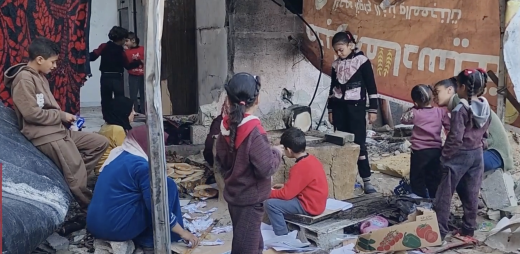
Updated translation of a joint statement originally published in Arabic on 13 January 2024.
The Palestinian Center for Human Rights (PCHR), Al Mezan, and Al-Haq voice profound apprehension regarding the proliferation of epidemics and various infectious diseases among the internally displaced population residing in shelters and makeshift tents in open areas across the entire Gaza Strip. This is directly linked to the severe overcrowding, extended displacement periods, and the insufficient availability of hygiene and health necessities in Gaza, including in shelters, stemming from the Israeli displacement policy and the ongoing genocidal military campaign now entering its fourth month.
As part of its genocidal military campaign, Israel imposed a total siege on Gaza, preventing the entry of essential needs, including water, food, medicine, and fuel, which is necessary for operating desalination water plants and sewage pumps. Although some aid is currently allowed to enter Gaza, its scope and quantity remains restricted and falls short of meeting the essential needs of the population, leaving many without sufficient supplies.
Dr. Mousa Abed, the Director General of Primary Care at the Palestinian Ministry of Health, told our teams that the overcrowding of hundreds of thousands of displaced people in southern Gaza has led to the proliferation of various infectious diseases. He further emphasized that seasonal diseases now present a substantial threat to the lives of residents, exacerbated by the collapse of the health system in Gaza’s northern and middle areas.
In northern Gaza, the inability of ambulance and civil defense crews to retrieve the bodies of hundreds of killed Palestinians, now decomposing beneath the rubble, is a major contributing factor to the spread of epidemics and serious diseases. Additionally, severe damage to vital infrastructure, such as water and sewage networks, has led to the contamination of drinking water, coupled with a scarcity of hygiene supplies, elevating the potential for the spread of bacterial infections. All of this unfolds against a backdrop of challenges in adhering to basic infection prevention and control measures across the entire Gaza Strip.
In southern Gaza, overcrowded shelters, predominantly housing children and women, foster an environment that facilitates the swift transmission of diseases. The absence of basic hygiene and care necessities, including access to clean water, sufficient food, and sanitary facilities, further exacerbates the situation. Adding to the severity, the buildup of waste and inadequate sewage disposal in these areas poses substantial health risks.
The situation is further compounded by the concentration of the majority of Gaza's population in the Rafah District, which lacks the essential infrastructure to accommodate over 1.3 million internally displaced persons, in addition to its original population of around 280,000. Rafah is grappling with severe challenges, particularly in the realm of inadequate health services. The city relies on just one government hospital, equipped with a bed capacity limited to 65 beds, and is strained by a shortage of various medical specialties. Both the Emirati Government Hospital for Maternity and the Kuwaiti Private Hospital are ill-equipped to address the diverse healthcare needs, especially given the overall collapse of the health sector driven by Israeli attacks and the overwhelming pressure caused by a high number of injuries.
Dr. Salah Al-Jabari, stationed at the medical facility within the shelter at Al-Salam School east of Rafah, shared with our field researchers that diseases like diarrhea, gastroenteritis, and upper respiratory tract infections are rapidly spreading, particularly among children. He noted that the medical facility attends to approximately 150 cases daily, predominantly involving children, women, and the elderly. The surge in infections among displaced individuals within the school is attributed to contamination, extensive overcrowding, insufficient toilet facilities, and the absence of water, soap, and sanitary hygiene tools.
Dr. Mousa Abed told us that the Palestinian Ministry of Health monitored around 626,000 cases of diseases in southern Gaza, while the epidemiological situation in northern Gaza remains uncertain and underreported. Specifically, there were 180,000 cases of respiratory infections, 250,000 cases of mumps, 135,000 cases of diarrhea, 26,000 cases of chickenpox, and 35,000 cases of lice infestation. Instances of jaundice affecting both adults and children were also reported, prompting concerns about the potential presence of viral hepatitis. However, the limited medical resources and a shortage of testing kits impede the ability to conclusively confirm these infections.
Dr. Abed underscored that the Israeli military has destroyed most of Gaza’s health system. Out of the 52 primary healthcare clinics in Gaza, only seven are currently operational, intensifying the challenges in controlling and addressing the spread of diseases within shelters. It is noteworthy that 30 out of 36 hospitals in the Gaza Strip are presently non-operational due to ongoing bombing, destruction, or resource shortages. Despite the partial reopening of certain hospitals and health centers, displaced individuals in northern Gaza are currently experiencing a shortage of adequate health services.
Additionally, there is a severe shortage of medicines for maternal and child health, with only 20% available due to significant deficits in both the private and non-governmental sectors. Health clinics ceased administering vaccinations to infants from early October for a span of several weeks. On 28 December 2023, international organizations were able to resume vaccinations despite the fact that certain crucial vaccines, such as those for rotavirus and polio, essential in the fight against severe diseases, remain unavailable.
Doctors have also noted the proliferation of Hepatitis A among children due to poor hygiene, the use of communal bathrooms, and the inability of children to wash their hands with water and soap. Dr. Al-Jabari emphasizes that patients with Hepatitis A need isolation and a diet rich in vegetables and fruits, which, regrettably, are currently unavailable and cannot be delivered under these challenging circumstances.
In his testimony to our teams, the father of six-year-old Joud Al-Dabari stated that his daughter contracted Hepatitis A due to inadequate hygiene practices and the use of communal toilets. Al-Dabari further explained that his daughter now requires isolation, a challenging prospect as she currently resides in a classroom with approximately 50 others, including children, women, and the elderly. Additionally, she needs access to nutritious food, a requirement made difficult by its scarcity in markets and high prices. Al-Dabari is currently concerned about the potential infection of his other children and the children in the same classroom. He pointed out that sometimes parents intentionally hide their children's Hepatitis A infection due to the lack of isolation facilities, leading to a significant spread of the disease.
Concerns among medical professionals extend to the potential development of infectious diseases like diarrhea, meningitis, and encephalitis, as documented in several cases. Managing these diseases becomes increasingly challenging given the shortage of medical resources. Some patients suffering from chronic respiratory distress require continuous oxygen, a service not provided in the shelters. Shelters are additionally grappling with a severe shortage of rehydration solutions crucial for children experiencing diarrhea and dehydration. As an alternative, doctors guide parents on preparing a rehydration solution by adding salt and lemon to water for administering to their children.
Dr. Aya Awwad, working in a shelter for displaced people, informed our field researchers that scabies, lice, and chickenpox are rapidly spreading among children due to acute overcrowding, and the required medical care for these conditions is unavailable. Women in the shelters are experiencing severe urinary tract infections (UTIs) due to poor personal hygiene, a lack of water and sanitary facilities, and unhealthy and insufficient food intake. Many pregnant women in these shelters receive only iron supplements and painkillers, with some requiring special care and medications that are not currently available.
Professor Devi Sridhar, Chair of Global Public Health at the University of Edinburgh, warned that “unless something changes, the world faces the prospect of almost a quarter of Gaza’s 2 million population - close to half- a million human beings - dying within a year. These would be largely deaths from preventable health causes and the collapse of the medical system. It’s a crude estimate, but one that is data-driven, using the terrifyingly real numbers of deaths in previous and comparable conflicts.” She added: “We are likely to see more children dying from preventable disease than from bullets and bombs. While the Israeli government has spoken about safe zones for families to flee to, these aren’t anywhere near what we would consider safe public health zones. They don’t have clean water, functional sanitation and toilets, enough food, or trained medical staff with medicine and equipment. These are the basic needs that any human, especially babies and children, need to stay healthy and alive.”
The combined policies and military actions undertaken by Israel, as the Occupying Power, reveal a deliberate intent to force Gaza residents into a prolonged and severe humanitarian crisis. This intention is clearly articulated in statements made by various ministers within the Israeli government and its political establishment. May Golan, Israel's Minister for the Advancement of the Status of Women, declared, "all of Gaza's infrastructures must be destroyed to its foundation, and their electricity cut off immediately." Concurrently, Israel Katz, the then-Minister of Energy, affirmed the imposition of collective punishment by ceasing the supply of electricity and water to the Gaza Strip. Within the same vein, Giora Eiland, the former head of the Israeli National Security Council, who asserted, "The international community warns us of a humanitarian disaster and of severe epidemics. Severe epidemics in the South of Gaza will bring victory closer and reduce casualties among Israeli soldiers."
Israel’s intentional targeting of civilian infrastructure crucial for the survival of the Palestinian people in Gaza, including sewage, water and sanitation facilities, combined with the ongoing collapse of the healthcare system due to Israel's siege and attacks, is a deliberate effort to exacerbate the already severe humanitarian conditions and, thereby, deliberately inflict conditions of life calculated to bring about the physical destruction of Gaza’s population. Current evidence from the ground indicates that these policies have also led to the outbreak of epidemic diseases among hundreds of thousands of internally displaced people.
In light of the aforementioned circumstances, we are sounding the alarm regarding the emergence of epidemic diseases in Gaza, presenting a substantial risk of thousands of Palestinian deaths. This situation is also destined to further compound the already dire humanitarian conditions and the collapse of the healthcare system in Gaza. Immediate and decisive action is needed to address this critical situation.
To this end, we urgently call upon the international community to exert pressure on Israel to promptly cease its genocidal acts against Palestinians in Gaza, to facilitate the entry of humanitarian aid and end the siege on Gaza; and to enable the return of residents from the northern areas to their homes.
Lastly, we strongly urge international humanitarian organizations, including the World Health Organization, to intervene promptly to mitigate the catastrophic humanitarian conditions in Gaza. Swift action is essential to mitigate emerging risks and save the lives of Palestinians, especially vulnerable Palestinians, including children, patients, women and the elderly. We also call on these organizations to provide essential assistance and address the needs of displaced people in shelters, aiming to alleviate their suffering during this critical period.

